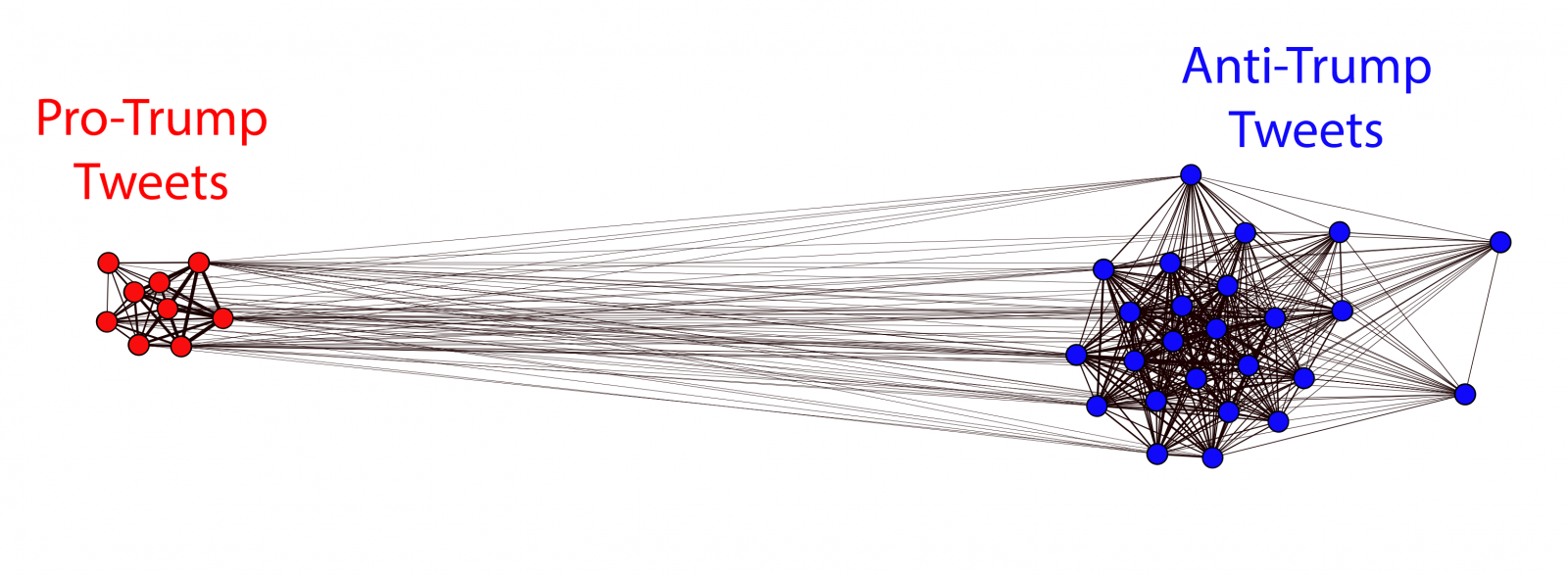Bridging networks with linear spaces to study attitudes and political polarization
A TNA experience @SoBigData R.I.
In recent years, more and more attention has been dedicated to the problem of social polarization. Specifically, about the increasing ideological separation between the political left and right [1]. The consequences of strong polarization in countries are increased hatred between people of opposing ideological sides and less ability to agree and coordinate on pressing social issues [2]. For example, attitudes on climate change and vaccination have been linked to political ideology.
The causes of this phenomenon are still not well understood, however several studies highlighted how the structure of social media seems to enhance this problem. Specifically, filter bubbles and echo chambers can push users towards “a world of tribes” [3]. However, to properly understand the phenomenon of polarization, attention should be given to attitudes and their (dynamic) relationship.
While many types of analysis of attitudes already exist, they typically approach attitudes and their relationship to each other in a “linear” fashion. For example, methods such as Factor Analysis aims at finding a few factors which summarize (in the form of a linear combination) the original items.
This “linear” approach to attitudes resulted in the production of multiple methods and measurements for analyzing polarization. However, since each method offers a very narrow view on this complex phenomenon, they also often produce contrasting results [4].
A diametrically opposite approach consists in treating attitudes as a complex system of interacting entities. This class of holistic approaches – which go under the name of Belief Network Analysis – formalize attitudes as nodes in a network. Despite offering more insights, results from these methods are usually hard to interpret, as they do not rely on any well-established theory.
In my work, I developed a method combining Belief Network Analysis with a well-established theory of psychological measurement (Item Response Theory). This produces a dual state of attitudes both as network nodes and as points in an attitude space (i.e. the left-right spectrum). This results in rich visualizations and numerical analysis from which it is possible to extract information about the attitude system [5].
While this method has proved to be useful in surveys data, it has never been applied to social media data. Indeed, social media (such as Twitter) offer a much wider data sample which would be extremely useful for the dynamic analysis of attitudes and polarization.
To address this point, I visited the laboratory of Prof. Dirk Helbing at ETH Zurich. There, I had the possibility of exchanging ideas and interacting with a team of experts from multiple fields. Indeed, all team members were extremely welcoming and prone to help with any kind of problem, from the technical to the administration-related ones. Such an environment allowed for extremely multidisciplinary discussions, fostering the development of innovative ideas.
The research conducted during the visit resulted in the achievement of the final goal, despite the initial challenges. Indeed, for a long time, I have tried to extract opinion data from tweets using methods from natural language processing. However, tweets often rely on very short messages and additional content (such as images and external links), making the extraction of the opinion unreliable.

tweets clustering blackTies noted
At the end, the problem was solved by applying the method directly on the tweets. Indeed, thanks to the duality property, the same method allows to determine the position of each tweet in the left-right political spectrum. However, the importance of such a visit was not limited to the scientific outputs, but also to the formation of bonding between researchers.
Author: Dino Carpentras
[1] https://www.pewresearch.org/politics/2014/06/12/political-polarization-in-the-american-public/
[2] Dunlap, R. E., McCright, A. M., & Yarosh, J. H. (2016). The political divide on climate change: Partisan polarization widens in the US. Environment: Science and Policy for Sustainable Development, 58(5), 4-23.
[3] Zollo, F., Bessi, A., Del Vicario, M., Scala, A., Caldarelli, G., Shekhtman, L., & Quattrociocchi, W. (2017). Debunking in a world of tribes. PloS one, 12(7), e0181821.
[4] Lelkes, Y. (2016). Mass polarization: Manifestations and measurements. Public Opinion Quarterly, 80(S1), 392-410.
[5] Carpentras, Dino, et al. “A Method for Exploring Attitude Systems by Combining Belief Network Analysis and Item Response Theory (resin).” PsyArXiv, 29

